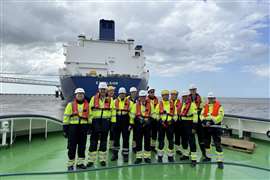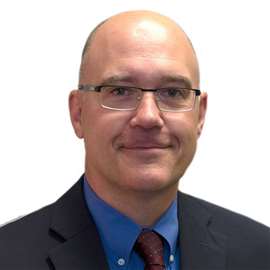Germany brings third floating LNG terminal online
May 27, 2025
Wilhelmshaven 2 facility adds offshore regasification capacity with technical innovations and green fuel potential
 Wilhelmshaven 2 LNG terminal was brought online by Deutsche Energy Terminal GmbH (DET). (Image: Deutsche Energy Terminal GmbH (DET))
Wilhelmshaven 2 LNG terminal was brought online by Deutsche Energy Terminal GmbH (DET). (Image: Deutsche Energy Terminal GmbH (DET))
Germany has further bolstered its natural gas import infrastructure with the commissioning of its third floating storage and regasification unit (FSRU), this one located 1.5 kilometers off the coast of Wilhelmshaven in Lower Saxony. The new terminal—Wilhelmshaven 02—is operated by Deutsche Energy Terminal GmbH (DET), a federal entity tasked with developing and managing Germany’s floating LNG terminals under the country’s LNG Acceleration Act.
Officially commissioned on May 26, 2025, the new terminal features a range of engineering and environmental innovations not yet seen elsewhere in Europe. At the heart of the installation is the FSRU Excelsior, a 291-meter-long vessel capable of regasifying up to 4.6 billion cubic meters (bcm) of LNG per year by 2027, following a phased ramp-up that begins with 1.9 bcm this year.
DET Managing Director Dr. Peter Röttgen highlighted the project’s strategic importance in light of Germany’s energy transition.
“We must reduce the risks of one-sided dependence on energy imports for our economy and consumers,” Röttgen said. “LNG, alongside pipeline gas, is making a significant contribution to our stability on the road to climate neutrality.”
Developed in partnership with ENGIE Deutschland GmbH and Tree Energy Solutions (TES), the Wilhelmshaven 02 terminal was planned, approved, and built in just two and a half years—less than half the time typically required for large-scale LNG infrastructure. The project includes a purpose-built island jetty, subsea utility corridors, and a complex mooring and offloading system capable of operating in challenging tidal conditions.
The offshore jetty itself is built in one of the strongest tidal current zones in Europe, requiring customized marine engineering solutions and high-precision installation techniques. To minimize environmental disturbance, power cables, data lines, and gas pipelines were buried in the seabed using a modular subsea transfer system from Norwegian firm ECOnnect Energy. This approach eliminated the need for surface buoys and reduced the ecological footprint in the Wadden Sea region.
From the jetty, regasified LNG is transported via subsea pipeline to a newly constructed onshore head station, where it enters the national transmission grid. The entire system includes real-time monitoring and safety shutdown mechanisms designed to meet Germany’s stringent gas infrastructure safety standards.
“We were responsible for the marine infrastructure and negotiated the FSRU charter with Excelerate Energy,” said Eric Stab, CEO of ENGIE Deutschland. “The rapid completion of this terminal is a credit to the professionalism of all partners involved.”
Innovations in regasification and biofouling control
The Excelsior—chartered from U.S.-based Excelerate Energy—is a purpose-built regasification vessel with a nominal sendout capacity of 500 million standard cubic feet per day (MMSCFD). The ship is equipped with three submerged combustion vaporizers (SCVs), which use seawater to heat and regasify LNG into pipeline-grade natural gas. Each SCV is capable of handling rapid ramp-ups and turndown rates to meet variable demand.
In a European first, DET is piloting an ultrasonic fouling prevention system aboard the Excelsior to address a persistent operational challenge: marine growth in seawater intake systems. Instead of relying on chemical biocides or frequent mechanical cleaning, the system uses high-frequency sound waves to deter barnacles, mussels, and algae from colonizing intake pipes.
“The goal is to reduce downtime, improve efficiency, and lower the environmental impact of operations,” said a DET technical spokesperson. “If successful, the technology could be scaled to other vessels in our FSRU fleet.”
The Excelsior also incorporates a closed-loop water treatment system and onboard emissions controls that align with IMO Tier III standards, minimizing nitrogen oxide (NOx) and sulfur oxide (SOx) emissions during port operations.
A bridge to synthetic fuels and future hydrogen imports
TES, which co-developed the terminal, plans to leverage Wilhelmshaven 02 as a launchpad for its broader green gas strategy. The company is advancing plans for a large-scale onshore terminal adjacent to the FSRU site, capable of receiving both LNG and synthetic e-NG—electric natural gas produced from green hydrogen and captured CO₂.
TES CEO Marco Alverà called the facility a dual-purpose asset.
“This project not only secures today’s energy needs but lays the groundwork for tomorrow’s green molecule economy. It’s about long-term resilience and sustainability,” Alverà said.
TES’s planned onshore terminal will use similar pipeline corridors and grid interconnection points, enabling a streamlined transition to low-carbon fuels when volumes become available.
A national energy pivot built on floating infrastructure
DET was established by the German government in 2022 in response to Russia’s invasion of Ukraine and the subsequent collapse of pipeline gas deliveries. Since then, it has deployed three state-backed FSRUs: Wilhelmshaven 01 and 02, and Brunsbüttel. Each terminal is designed to operate for at least ten years, bridging the gap between fossil gas dependence and a fully renewable energy system.
Together, the three terminals represent a combined annual import capacity of over 13 bcm, roughly equivalent to one-third of Germany’s pre-war pipeline imports from Russia.
The launch of Wilhelmshaven 02 underscores the German government’s strategic shift toward flexible, rapidly deployable LNG infrastructure, while also paving the way for climate-compatible alternatives.
“We are working at the intersection of energy security and energy transformation,” said Dr. Röttgen. “This terminal embodies both.”
MAGAZINE
NEWSLETTER

CONNECT WITH THE TEAM








